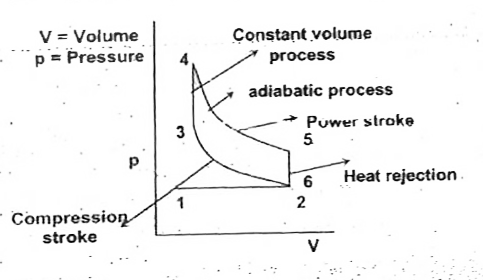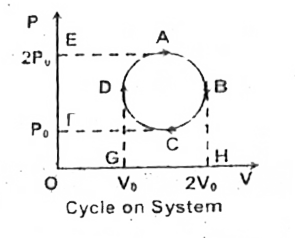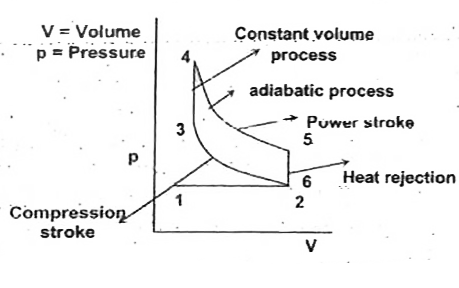To move an airplane through the air, thrust is generated by some kind of propulsion system. Beginning with the Wright brothers' first flight, many airplanes have used internal combustion engines to turn propellers to generate thrust. Today, most general aviation or private airplanes are powered by internal combustion (IC) engines, much like the engine in your family automobile. When discussing engines, we must consider both the mechanical- operation of the machine and the thermodynamic processes that enable the machine to produce useful work. We consider the thermodynamics of a four-stroke IC engine. 
Figure shown represents such a cycle which is used in all Internal combustion engines. The figure shows a p-V diagram of the cycle. Using the engine stage numbering system, we begin at the lower left with Stage 1 being the beginning of the intake stroke of the engine. The pressure is near atmospheric pressure and the gas volume is at a minimum. Between Stage 1 and Stage 2 the piston is pulled out of the cylinder with the intake valve open. The pressure remains constant, and the gas volume increases as fuel/air mixture is drawn into the cylinder through the-intake valve. Stage 2 begins the compression stroke of the engine with the closing of the intake valve. Between Stage 2 and Stage 3, the piston moves back into the cylinder, the gas volume.decreases, and the pressure increases because work is done on the gas by the piston. Stage 3 is the beginning of the combustion of the fuel/air mixture. The combustion occurs very quickly and the volume remains constant. Heat is released during combustion which increases both the temperature and the pressure, according to the equation of slate. Slage 4 begins the power stroke of the engine. Between Stage 4 and Stage 5, the piston is driiven towards the crankshaft, the volume in increased, and the pressure falls as work is done by the gas on the píston. At Stage 5 the exhaust valve is opened and the residual heat in the gas is exchanged with the surroundings. The volume remains constant and the pressure adjusts back to atmospheric conditions. Stage 6 begins the exhaust stroke of the engine during which the piston. moves back into the cylinder, the volume decreases and the pressure remains constant. At the end of the exhaust stroke, conditions have returned to Stage 1 and the process repeats itself. During the cycle, work is done on the gas by the plston between stages 2 and 3. Work is done by the gas on the piston between stages 4 and 5. The difference between the work done by the gas and the work done on the gas is the area enclosed by the cycle curve and is the work produced by the cycle. The work times the rate of the cycle (cycles per second) is equal to the power produced by the engine.
Choose.the correct statement.
During the compression stroke, the gas does positive work.
During the power stroke the gas.does positive work.
Between stage 1, 2, the work is done on the gas.
None of the above.
The correct Answer is:B
Topper's Solved these Questions
- HEAT AND TEMPERATUREBook:FIITJEEChapter:HEAT AND TEMPERATUREExercise:COMPREHENSIONS-III
Explore 3 Videos
- HEAT AND TEMPERATUREBook:FIITJEEChapter:HEAT AND TEMPERATUREExercise:COMPREHENSIONS-IV
Explore 2 Videos
- HEAT AND TEMPERATUREBook:FIITJEEChapter:HEAT AND TEMPERATUREExercise:COMPREHENSIONS-I
Explore 3 Videos
- GRAVITATIONBook:FIITJEEChapter:GRAVITATIONExercise:Numerical based Question
Explore 2 Videos
- KINEMATICSBook:FIITJEEChapter:KINEMATICSExercise:NUMERICAL BASED QUESTIONS DECIMAL TYPE
Explore 5 Videos
Similar Questions
A cyclic process is shown on a P-V diagram. The working fluid is an idal and corresponding thermodynamic co-ordinates are given. Here, P and V scales are so chosen that these cycles on P-V diagram appear to be circular.
Analyse these cycles on P-V diagram and answer the following questions about these proesses.

Analyse these cycles on P-V diagram and answer the following questions about hte processes.
What is the net work done in the given process
View SolutionAt certain pressure and 127∘C temperature the mean kinetic energy of hydrogen molecules is 8×10−12J. (Mass of hydrogen atom =1.7×10−27kg & atomic weight of nitrogen =14). Then
Root mean square speed of hydrogen molecule at 27∘C is
View SolutionWhen we look at the sky in a clear night, we find the sky full of stars, filling every. portion of the sky almost uniformly. But on a very careful observation through highly sophisticated instruments, one would observe dark areas in portions of the observable universe devoid of stars. Such a region is known as a dark nebula. A dark nebula is basically a cold gas cloud in interstellar space that contains enough material to block out light from stars behind it. A typical dark nebuta is about 20 light years in diameter and contains about 50 hydrogen atoms per cubic centimeter (monatomic hydrogen, not H2) at a temperature of about 20 K. (A light year is the distance light travels in vacuum in one year and is equal to 9.46×1015m).
What would be the mean free time (average time between collisions)
View SolutionA particle is projected radially outwards from the surface of a planet with an initial speed of 4.0km/s. Maximum height attained by the particle is h=900km. Find the radius of the planet taking g=10m/s2.
View SolutionTwo highways are perpendicular to each other : imagine them to be along the x-axis and the y-axis, respectively. At the instant t=0, a police car P is at a distance d= 400m from the intersection and moving at speed of 80km/h towards it along the x-axis. Motorist M is at a distance of 600m from the intersection and moving towards it at a speed of 60km/h along the y-axis . The minimum distance between the cars is
View Solution_________ is an important anti knock compound added to petrol used in internal combustion engines .
View SolutionIn internal combustion petrol/diesel engines, only cyclic processes are used, because:
View SolutionDistinguish between internal and external combustion heat engines.
View Solutionएक वायुमान में तीन इंजन A,B और C है। यदि तीनो इंजन ख़राब हो जाए, तो वायुमान दुर्घटनाग्रस्त हो जाएगा । यदि इंजन A,B और C के ख़राब होने की प्रायिकताएँ क्रमश: 0.03,0.02 और 0.05 है, तब वायुमान के दुर्घटनाग्रस्त न होने की प्रायिकता क्या है?
View SolutionSuppose that airplane engines oprate independently and fail with probabitily equal to 0.4. Assuming that a plane makes a safe flight if at least on half of its engins run, then the probabitily for a succesful flight of 4-engine plane is
View SolutionSuppose that airplane engines oprate independently and fail with probabitily equal to 0.4. Assuming that a plane makes a safe flight if at least on half of its engins run, then the probabitily for a succesful flight of 4-engine plane is
View SolutionHumans are like an "internal combustion engine". Because
View SolutionTo move an airplane through the air, thrust is generated by some kind of propulsion system. Beginning with the Wright brothers' first flight, many airplanes have used internal combustion engines to turn propellers to generate thrust. Today, most general aviation or private airplanes are powered by internal combustion (IC) engines, much like the engine in your family automobile. When discussing engines, we must consider both the mechanical- operation of the machine and the thermodynamic processes that enable the machine to produce useful work. We consider the thermodynamics of a four-stroke IC engine.

Figure shown represents such a cycle which is used in all Internal combustion engines. The figure shows a p-V diagram of the cycle. Using the engine stage numbering system, we begin at the lower left with Stage 1 being the beginning of the intake stroke of the engine. The pressure is near atmospheric pressure and the gas volume is at a minimum. Between Stage 1 and Stage 2 the piston is pulled out of the cylinder with the intake valve open. The pressure remains constant, and the gas volume increases as fuel/air mixture is drawn into the cylinder through the-intake valve. Stage 2 begins the compression stroke of the engine with the closing of the intake valve. Between Stage 2 and Stage 3, the piston moves back into the cylinder, the gas volume.decreases, and the pressure increases because work is done on the gas by the piston. Stage 3 is the beginning of the combustion of the fuel/air mixture. The combustion occurs very quickly and the volume remains constant. Heat is released during combustion which increases both the temperature and the pressure, according to the equation of slate. Slage 4 begins the power stroke of the engine. Between Stage 4 and Stage 5, the piston is driiven towards the crankshaft, the volume in increased, and the pressure falls as work is done by the gas on the píston. At Stage 5 the exhaust valve is opened and the residual heat in the gas is exchanged with the surroundings. The volume remains constant and the pressure adjusts back to atmospheric conditions. Stage 6 begins the exhaust stroke of the engine during which the piston. moves back into the cylinder, the volume decreases and the pressure remains constant. At the end of the exhaust stroke, conditions have returned to Stage 1 and the process repeats itself. During the cycle, work is done on the gas by the plston between stages 2 and 3. Work is done by the gas on the piston between stages 4 and 5. The difference between the work done by the gas and the work done on the gas is the area enclosed by the cycle curve and is the work produced by the cycle. The work times the rate of the cycle (cycles per second) is equal to the power produced by the engine.
Consider that the above diagram represents an ideal such cycle then choose the incorrect statement fora corresponding real cycle.
View SolutionWhat is working substance in internal combustion engine ?
View Solutionहवाई जहाज के पुर्जे (parts) बनाने वाले निर्माता एक ऐसा इंजिन बनाता है जिसका उड़ान के दौरान असफल होने की प्रायिकता p है। दो हवाई जहाजों में इसी प्रकार का इंजिन लगाया गया है। एक हवाई जहाज में इस प्रकार के तीन इजिन तथा अन्य हवाई जहाज में 5 इंजिन लगाये गये हैं। हवाई जहाज तब ही दुघर्टनाग्रस्त होता है जबकि इसमें लगाये इंजिनों में से आधे से अधिक असफल होते हैं। यदि दोनों हवाई जहाजों के दुघर्टनाग्रस्त होने की प्रायिकता समान है, तो p का मान है
View Solution

